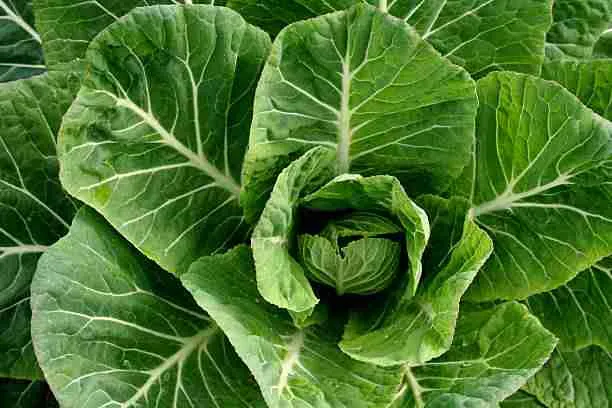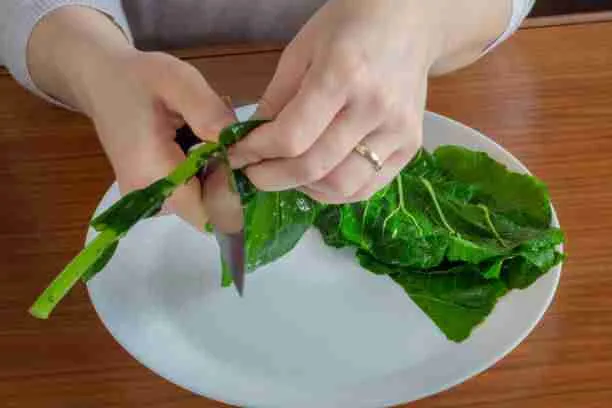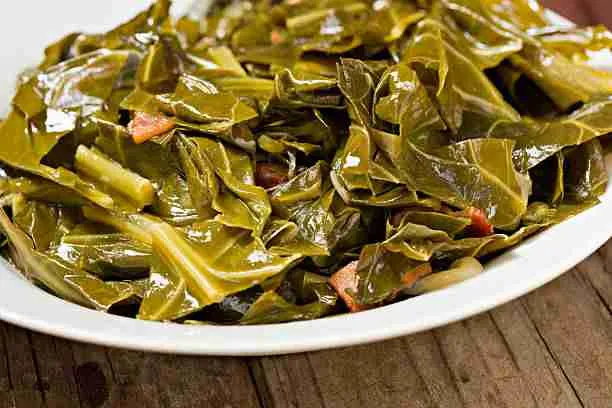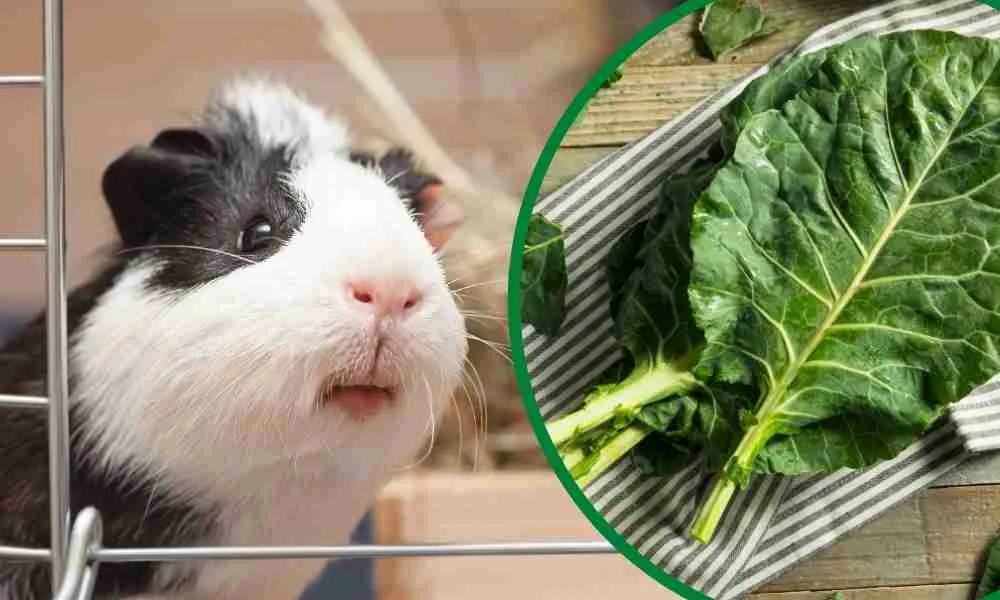Collard greens are leafy veggies that make great salads! Feeding your guinea pigs raw vegetables is a good way to keep them healthy.
Just in case you’re wondering – Do guinea pigs eat collard green?
Yes! Guinea pigs can eat collard greens. These leafy veggies have lots of fiber and vitamins C that help to keep your cavy healthy.
However, it also is rich in calcium and oxalates, so it’s best to serve only moderate amounts to your cavy.
In addition, guinea pigs can only eat them raw and fresh. You can’t feed this to them as a major meal.
It’s clear now that cavies can have collard greens. However, it’s important to know the right part of this veggie to feed them.
So, I wonder – What part of collard green do guinea pigs eat?
Let’s find out as we go deeper into this article…
Table of Contents
What Part of Collard Can Guinea Pigs Eat?
Parts like the leaves of this veggie are safe for guinea pigs to eat. They are normally the main part of these veggie treats.
However, there are other parts that you should know about, like the stems and seeds. Are they both safe to feed your pet too?
Let’s find out…
Do Guinea Pigs Eat Collard Green Stems?
Absolutely! Guinea pigs can also eat the stems of collard greens. They’re rich sources of vitamin C and fiber for your furry friends.
However, this part has a lot of calcium, so you should only feed your guinea pigs bits of it to keep things safe.
Also, it’s equally important that you always wash this part before feeding them to your cavy. This helps to get rid of any chemicals and bacteria on them that can make your pet sick.
Do Guinea Pigs Eat Collard Green Seeds?
Not at all! You shouldn’t serve collard green seeds to your cavy.
Generally, seeds are not safe for guinea pigs as they cause choking hazards, especially when they get stuck in your cavies’ throats.
Also, the seeds of this veggie are tough and not safe for your cavy to chew. Even humans have to cook them for a long time to soften them for eating.
For guinea pigs, pieces of these seeds could stick in between their teeth and damage them. In addition, collard greens seeds are bitter, so they’re not even what your little pets will enjoy eating either.
How Much Do Guinea Pigs Eat Collard Greens?
You should only serve your guinea pigs one leaf of collard green.
However, since they’re having it for the first time, give them smaller amounts first. It’s always better to introduce new foods slowly into their diet.
If your cavy reacts badly to collard greens, don’t feed them for a while. And then, resume feeding them this treat in a smaller size till they get used to it.
However, if they eat it without showing any negative signs, go ahead offering them the normal serving sizes.
Can Guinea Pigs Eat Collard Green Every Day?
No! Guinea pigs cannot eat collard greens every day. Their daily meal should remain hays.
However, since this veggie isn’t a daily snack, how often can they have it then?
Here’s the answer – Guinea pigs should have collard greens only once a week. This helps reduce the chances of calcium hurting your furry friends.
However, let’s look at the nutritional value of collard green per 100 g serving below.
Nutritional Value of Collard Green
| Nutrients | Per 100 g |
| Fiber | 4g |
| Calories | 32 Kcal |
| Vitamin C | 35.3 mg |
| Vitamin A | 251 μg |
| Vitamin K | 437.1 μg |
| Protein | 3 g |
| Calcium | 232 mg |
| Potassium | 213 mg |
| Sugar | 0.5 g |
| Phosphorus | 25 mg |
| Water | 89.62 g |
| Fats | 0.6 g |
Benefits of Feeding Guinea Pigs Collard Greens

Boosts Immunity
Vitamin C is an important nutrient for cavies and is present in collard greens. This nutrient as well as vitamin A, and other antioxidants can help fight many diseases that might happen in your cavies’ bodies.
Also, these vitamin C-enriched veggies help prevent scurvy, a common disease to guinea pigs.
The only way they can prevent this is to get this nutrient from foods that are rich sources, like collard greens.
Improves Vision
Leafy veggies normally have lots of vitamin A in them, and collard greens are no exception. This vitamin can help keep your cavies’ eyesight in good condition.
Generally, older cavies tend to have poor sight. So, serving them this leafy veggie is a way to care for their sight.
Think about this, your little pets won’t have problems recognizing you!
Helps in Digestion
Some guinea pigs have problems digesting food. The dietary fiber in collard greens will help guinea pigs’ weak digestive systems to digest other foods easily.
In addition, this nutrient will also help improve good bowel movement and prevent a lot of digestive issues that guinea pigs commonly face.
Improves Cardiovascular Wellbeing
Potassium is also in this veggie and they promote good breathing by helping the heart muscles contract and relax well. Also, it supports a good heartbeat rate and lowers the chances of having high blood pressure.
Also, if the hearth is in good condition, your cavy will be safe from a lot of heart-related issues.
Supports Bones and Teeth Development
Guinea pigs are herbivores and their teeth are very important for them in feeding, especially grinding their foods.
These plant foods don’t digest easily so your cavies need to chew a lot to make things easier.
So, it is important that their teeth stay strong and healthy.
Also, it’s equally important for their bones to remain strong to support their bodies. If they lack calcium, they’ll be weak and that’s not good at all for these sensitive pets.
Boosts Wound Recovery
In collard green, you’ll also find a good amount of vitamin K. These vitamins helps blood clotting; This will ensure your little pets don’t bleed so much if they get injured.
Furthermore, they’ll heal very fast as wounds close up quickly.
Helps in Hydration
Collard greens are almost made up of water. Your guinea pigs need to stay hydrated for many reasons. It keeps them safe from diseases, regulates temperature, and keeps organs working in good condition.
So, aside from the regular water, you give your cavy daily, these veggies help hydrate them well too.
Risk in Feeding Guinea Pigs Collard Greens
Chemical Poisoning
Your cavies can get ill if they eat collard green that has chemicals on them. These leafy veggies, especially ones in stores, are normally grown with chemicals, like herbicides and pesticides.
These chemicals can harm your cavies. This is why you need to wash them very well before serving your pet.
Kidney and Bladder Stones
Guinea pigs don’t need a lot of calcium. However, collard greens are high in calcium. Excess calcium, together with oxalates in these veggies, can form a kidney stone.
These kidney and bladder stones get pretty painful when they build up. You won’t want your little pet experiencing this.
Also, If they get stuck in the bladder, they can cause urinary tract infections which is very bad for guinea pigs’ health. In serious cases, it can lead to death.
Digestive Problems
Collard green is rich in fiber and that’s good for your guinea pig’s digestive system.
However, when you overfeed your guinea pigs collard green treats, they might end up getting excess fiber which will then do bad things to your guinea pigs’ health.
Sadly, these nutrients can also do the opposite to your little pet’s digestive system. Too much fiber can cause digestive issues like:
- gas,
- bloating,
- diarrhea,
- and vommiting.
How to Serve Guinea Pigs Collard Greens

Serving collard greens the right way will ensure that your furry friends get to enjoy them without trouble. So, to make sure you get it right, follow these easy steps below:
Step 1: Choose Only Fresh Collard Greens
As you plan to prepare this treat for your cavy, you can’t just use any collard green you see. Most importantly, they must be fresh and still green.
So, don’t use leftovers or ones that are already drying up.
Step 2: Wash Collard Greens Thoroughly
This step isn’t one you should skip at all especially when it’s about what your cavy will eat.
Preferably, in a bowl of water, dip this veggie and shake as you wash off any sand or dirt and chemicals on them. It cleanses this leafy veggie much better than rinsing under running water.
Step 3: Cut Collard Greens into Small Sizes
Pick a single collard green leaf and cut it into smaller pieces. This is to ensure your guinea pigs eat them easily without going through the stress of tearing them apart.
Also, a better way to slice this veggie is to make sure some of the sliced leaves still have some parts of the stem on them. This way, you’ll get to include both eaves and stem in this treat without exceeding the proper serving sizes.
Step 4: Serve Already Prepared Collard Green
Serve collard green treats on clean surfaces. You can make things more balanced by mixing them up with other veggies as salads for your pet.
However, you should only use veggies that are pretty low in calcium.
Take Note!
Every veggie is better when it’s organic. If you have homegrown collard greens in your garden that weren’t grown with any chemicals, they’re better to use.
Also, whenever your guinea pigs are done having this veggie treat, get rid of any leftovers in their cages or feeding area. They get exposed to flies and even bacteria start to grow on them.
You won’t want your cavy to eat this at all as they’ll fall sick.
Collard Green Alternatives for Your Cavies
It’s not proper to feed your little pet one type of veggie snack every time. Try to swap foods in their diet, especially veggies. This ensures that guinea pigs get the important nutrients they need from different sources every day.
Interestingly, there are other veggies you could serve as treats to your furry friends aside from collard green.
Here are some healthy veggies that you can add to your cavies’ diet:
| Cabbage | Kale | Beet | Sweet Potato |
| Parsley | Arugula | Carrot | Artichoke |
| Lettuce | Cucumber | Bell pepper | Basil |
| Broccoli | Tomato | Watercress | Romaine |
| Spinach | Celery | Zucchini | Snap pea |
| Brussel sprouts | Asparagus | Green beans | Cilantro |
In addition, before you serve any of these veggies, you shouldn’t forget that moderation is important for most veggies.
So, try to know the correct serving size of anyone you pick, and also the risks they could create on your pet’s health.
Can Guinea Pigs Eat Cooked Collard Greens?

A big NO! You shouldn’t serve cooked collard greens to guinea pigs at all. It’s a general thing for guinea pigs not to eat cooked foods.
Their digestive systems are too sensitive to digest cooked foods. Instead, cooked collard greens will end up creating serious health problems for your little pets.
Additionally, the ingredients normally used to cook these veggies are also bad for your guinea pigs’ health
Also, this veggie will have little or no nutrients at all once they’re cooked, so it’s useless serving it to them. However, your guinea pigs can only benefit from collard greens when they’re still raw and fresh.
Can Guinea Pigs Eat Canned Collard Greens?
No, you can’t feed canned collard greens to guinea pigs. They’re also processed and guinea pigs will find it hard digesting them.
Also, these canned veggies are normally made with additives and preservatives. All of which are bad for your cavy’s well-being.
In addition, fresh collard greens are just the right ones for your cavy, so any processed form of these veggies is a no-no.
Final Thoughts
In summary, guinea pigs can eat collard greens. These are healthy veggies you can add to their diet. It has important nutrients like vitamin C and fiber, which your cavy needs every day to stay healthy.
However, you shouldn’t serve this as a main meal to your cavy.
Only serve as snacks and in moderation because of the high calcium and oxalate in them. About one small collard green leaf will do.
In addition, your guinea pigs’ diet should mainly be hay, especially Timothy hay.
Remember “moderation is the key!”
If you find this article helpful, share it with your guinea pig lover friends!
